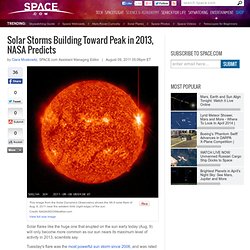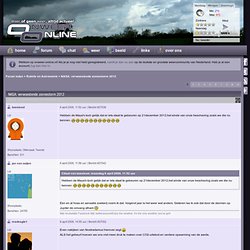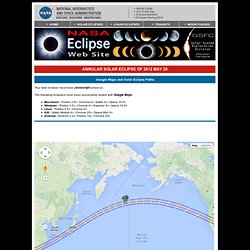

Solar Storms Building Toward Peak in 2013, NASA Predicts. Solar flares like the huge one that erupted on the sun early today (Aug. 9) will only become more common as our sun nears its maximum level of activity in 2013, scientists say.

Tuesday's flare was the most powerful sun storm since 2006, and was rated an X6.9 on the three-class scale for solar storms (X-Class is strongest, with M-Class in the middle and C-Class being the weakest). Flares such as this one could become the norm soon, though, as our sun's 11-year cycle of magnetic activity ramps up, scientists explained. The sun is just coming out of a lull, and scientists expect the next peak of activity in 2013. The current cycle, called Solar Cycle 24, began in 2008. "We still are on the upswing with this recent burst of activity," said Phil Chamberlin, a solar scientist at NASA's Goddard Space Flight Center in Greenbelt, Md., who is a deputy project scientist for the agency's Solar Dynamics Observatory, a sun-studying satellite that launched in February 2010. A more active sun. NASA Science. The Sun Does a Flip.
NASA scientists who monitor the Sun say that our star's awesome magnetic field is flipping -- a sure sign that solar maximum is here.

Listen to this story (requires RealPlayer) February 15, 2001 -- You can't tell by looking, but scientists say the Sun has just undergone an important change. Our star's magnetic field has flipped. The Sun's magnetic north pole, which was in the northern hemisphere just a few months ago, now points south. It's a topsy-turvy situation, but not an unexpected one. "This always happens around the time of solar maximum," says David Hathaway, a solar physicist at the Marshall Space Flight Center. Above: Sunspot counts, plotted here against an x-ray image of the Sun, are nearing their maximum for the current solar cycle. Solar Storm Warning. + Play Audio | + Download Audio | + Historia en Español | + Join mailing list March 10, 2006: It's official: Solar minimum has arrived.

Sunspots have all but vanished. Solar flares are nonexistent. The sun is utterly quiet. Like the quiet before a storm. This week researchers announced that a storm is coming--the most intense solar maximum in fifty years. That was a solar maximum. NASA: verwoestende zonnestorm 2012 - onweer-online.nl. ******Bron: ******

Nasa waarschuwt voor zonneactiviteit in 2012 - Wetenschapsforum. XpreZ, on 7 July 2008, 23:35, said: Is dat echt zo?

Ik heb dit van het pietpaulusma forum af gehaalt. kan iemand bevestigen of dit echt waar is Ik vraag me dan ook of het echt bevestigd is door nasa, en niet zo'n persoontje die in de maya's gelooft en dit verhaal verzonnen heeft. Quote NASA waarschuwt voor zonneactiviteit in 2012 Sunday, 18 March 2007 Gegevensanalyse van de zon door de NASA heeft aangetoond dat tijdens de zonneactiviteitspiek in 2012 de zonneactiviteit 30 tot 50 procent heviger is dan de vorige piek in de zonnecyclus. Er is een officiele waarschuwing gegeven voor dat jaar. Annular Solar Eclipse of 2012 May 20. Google Maps and Solar Eclipse Paths Your web browser must have Javascript turned on.

The following browsers have been successfully tested with Google Maps: Macintosh - Firefox 3.5+, Chrome 4+, Safari 4+, Opera 10.5+ Windows - Firefox 3.5+, Chrome 4+, Explorer 8+, Opera 10.5+ Linux - Firefox 3.5+, Chrome 4+ iOS - Safari Mobile 4+, Chrome 25+, Opera Mini 5+ Android - Android 2.3+, Firefox 19+, Chrome 25+ Introduction This interactive Google map shows the path of the Annular Solar Eclipse of 2012 May 20 . The green marker labeled GE is the point of Greatest Eclipse. You can be hundreds of miles from the theoretical point of Greatest Duration and still enjoy annularity lasting within a fraction of a second of the maximum possible (as long as you stay within several miles of the central line).
User Directions. Multimedia - Video Gallery. Marshall Solar Physics. The "sunspot number" is then given by the sum of the number of individual sunspots and ten times the number of groups.

Since most sunspot groups have, on average, about ten spots, this formula for counting sunspots gives reliable numbers even when the observing conditions are less than ideal and small spots are hard to see. Monthly averages (updated monthly) of the sunspot numbers (181 kb JPEG image), (307 kb pdf-file), (62 kb text file) show that the number of sunspots visible on the sun waxes and wanes with an approximate 11-year cycle. (Note: there are actually at least two "official" sunspot numbers reported. The International Sunspot Number as compiled by the Solar Influences Data Analysis Center in Belgium, has been revised recently (V2.0 -- summer 2015), and should now more closely match the NOAA sunspot number. The NOAA sunspot number is compiled by the US National Oceanic and Atmospheric Administration. NASA TV. Isslivestream.asx (video/x-ms-asf Object)